How closely related is your spouse?
I have written on the children produced by mixed-race couples before, and since it went so well, it's time to try again. Only this time, another angle: the parents themselves. Someone reminded me of research showing that mixed-race marriages are less stable. So I had a look at the literature, tweeting my findings while skimming papers. Here they are in a nicer format. You can find some more studies here. I picked newer, and large studies. The basic finding is that interracial marriages are less stable on average, but it depends on the specific combinations of race and sex. If one controls for stuff, one can make some of the associations 'go away'. Still, a prudent person would think of this as an extra risk factor, and avoid it insofar as this is possible. There is no difference here with avoiding other risk factors, such as a spouse with mental illness diagnoses. So this post isn't advocating a ban on interracial marriage anymore than it is advocating banning mentally ill people from marrying. Yet somehow I get the feeling it will be deliberately interpreted that way.
Zhang, Y., & Van Hook, J. (2009). Marital dissolution among interracial couples. Journal of Marriage and Family, 71(1), 95-107.
Increases in interracial marriage have been interpreted as reflecting reduced social distance among racial and ethnic groups, but little is known about the stability of interracial marriages. Using six panels of Survey of Income and Program Participation (N = 23,139 married couples), we found that interracial marriages are less stable than endogamous marriages, but these findings did not hold up consistently. After controlling for couple characteristics, the risk of divorce or separation among interracial couples was similar to the more-divorce-prone origin group. Although marital dissolution was found to be strongly associated with race/ethnicity, the results failed to provide evidence that interracial marriage is associated with an elevated risk of marital dissolution.
...
Table 2 presents the results of the Cox Proportional Hazards models of marital dissolution (hazard ratios are displayed). Model 1 includes an indicator of all types of interracial marriages without any controls (Model 1 does not exactly replicate the descriptive results in Table 2 because it conditions the hazard on the duration of marriage). Indeed, interracial marriages are less stable. The risk of marital dissolution among mixed marriages is about 1.21 times that of (or 21% higher than) non-mixed endogamous marriages (Table 2, Model 1), and this did not change after adding controls for marriage cohort and region of residence (Model 2). When we added other potential marital dissolution risk factors in Model 3, the hazard ratio associated with mixed marriage declined by 25% to 1.15, and dropped in significance (p < .01 to p < .10). In general, younger age of first marriage, age and educational differences among the spouses (particularly when the husband is more than two years younger or less educated than the wife); lower levels of education (less than college); lower income; and having no or fewer young children were significantly associated with marital instability. Interracial couples tend to have higher incomes and older ages at marriage (both of which are associated with lower rates of dissolution), so these characteristics cannot explain their higher levels of divorce or separation. Although, mixed marriages are also more likely to involve larger differences in age and education between spouses (consistent with the first homogamy hypothesis), which could partially explain their higher risks of marital dissolution.
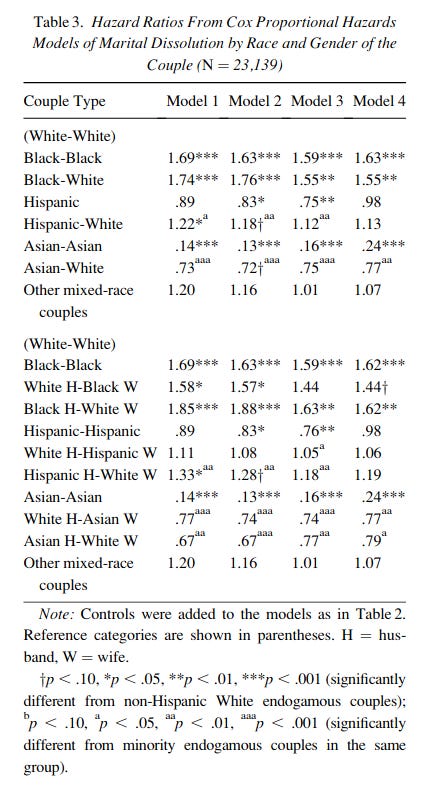
Kreider, R. (2000, March). Interracial marriage and marital instability. In Presentation at the Annual Meeting of the Population Association of America, Los Angeles, CA.
This paper uses the 1995 National Survey of Family Growth [n = 10.8k] to consider whether interracial first marriages are less stable than endogamous marriages. While some characteristics typical of interracial couples predict that they should be more stable, others predict less stability. Using a life table, I find that interracial first marriages are 1.4 years shorter on average than endogamous first marriages. I calculate survival curves for various subgroups to see whether there are particular interracial couples who are less stable than endogamous couples. I find that interracial couples who married young are more likely to divorce than those who married later. Using event history analysis, I find that after controlling for determinants of divorce, interracial couples are about 50 percent more likely to divorce than endogamous couples, although as a predictor, being in an interracial couple is less important than many other characteristics we know to predict an increased risk of divorce.
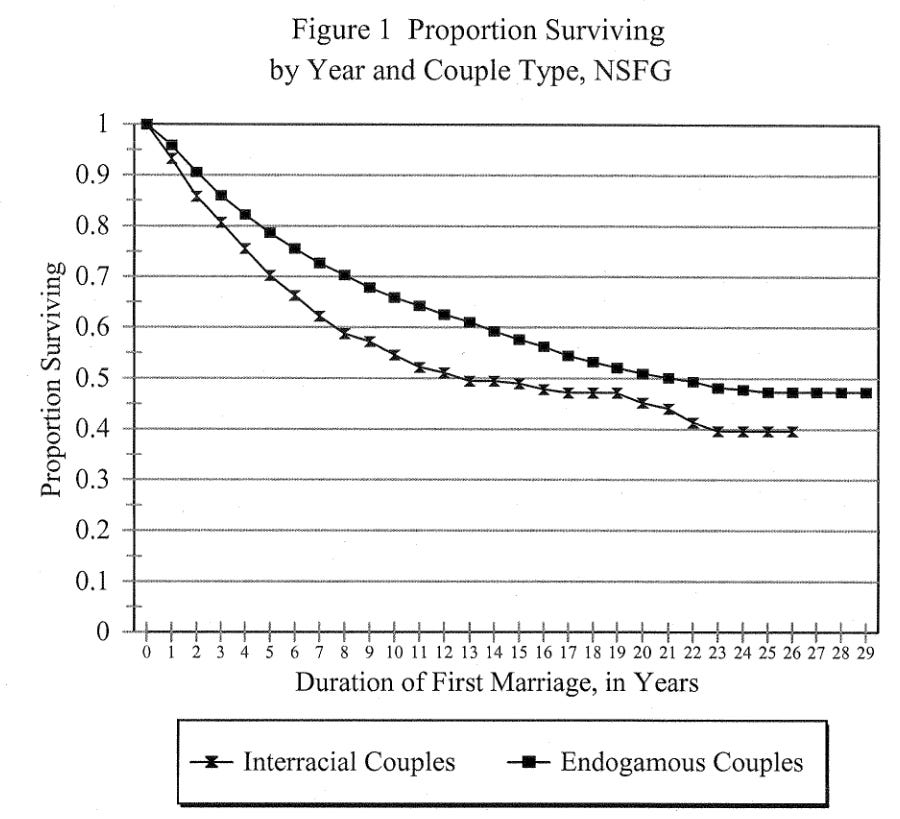
Wang, H., Kao, G., & Joyner, K. (2006). Stability of interracial and intraracial romantic relationships among adolescents. Social Science Research, 35(2), 435-453.
Using data from the National Longitudinal Study of Adolescent Health (or Add Health), a nationally representative sample of adolescents in 1994–1995 [n is about 20k], we compare the stability of interracial and intraracial dating relationships among white, black, Hispanic, Asian, and Native American adolescents by using Cox Regression Models and Multiple Imputation techniques that correct for missing data problems. We find that adolescents who are involved in interracial relationships are more likely to terminate their relationships than their counterparts involved in intraracial relationships even after we adjust for individual, relationship and social network factors. Without Multiple Imputation techniques for missing data, we find no difference in relationship stability between interracial and intraracial couples. We demonstrate that adolescents involved in interracial romance are less likely to reveal their relationships to their families, to the public eye and less likely to meet their partners’ parents. These patterns suggest that interracial relationships are less likely than intraracial relationships to be supported by significant others.
... As the second step, we examine the effect of interracial dating on relationship stability after adjusting for a set of demographic variables such as respondents’ age, gender, racial identity, generational status, dating frequency, and their mother’s education. We find that interracial dating still significantly affects relationship stability after we control for a set of demographic variables. Interracial dating relationships are 11% more likely to break up than intraracial dating relationship after we control for respondents’ age, gender, racial identity, generational status, dating frequency, and mother’s education.
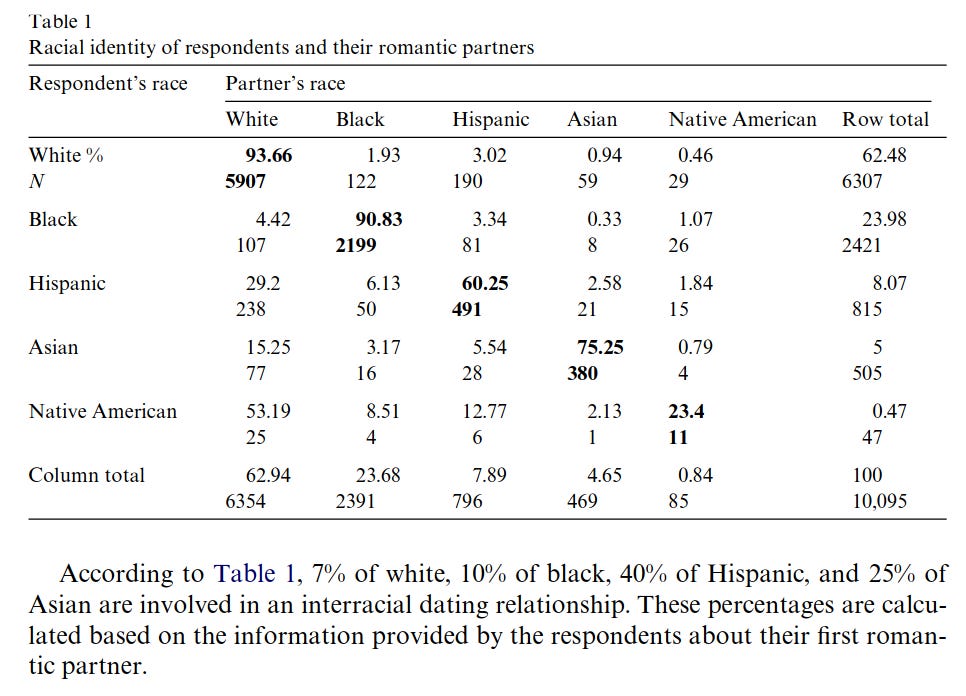
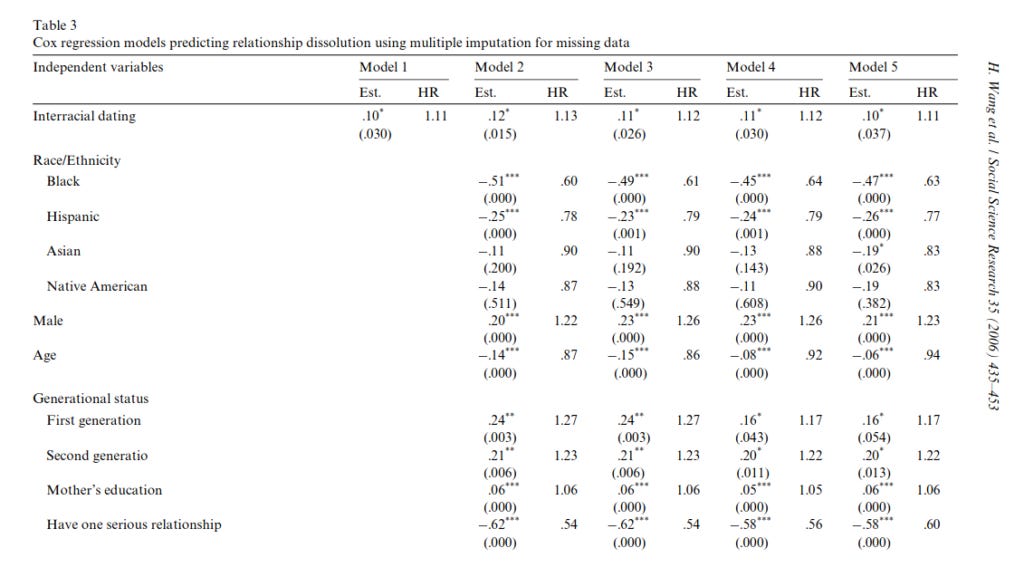
If you read the above and are confused as to why non-whites self-report lower rates of dissolution, you may find this post interesting.
Bratter, J. L., & Eschbach, K. (2006). ‘What about the couple?’Interracial marriage and psychological distress. Social Science Research, 35(4), 1025-1047.
We explore the association between racial composition of couples—that is, whether they are interracial or homogamous—and the psychological distress of their members, as measured in a screening scale for non-specific psychological distress. We use a pooled 1997–2001 National Health Interview Survey sample of the married and cohabiting population of the United States []. We compare the odds of distress for interracial vs. same race married/cohabiting adults. There are several key findings. Interracial marriage is associated with increases in severe distress for Native American men, white women, and for Hispanic men and women married to non-white spouses, compared to endogamous members of the same groups. Higher rates of distress are observed for intermarried persons with African American or Native American husbands or wives, and for women with Hispanic husbands. Lower socioeconomic status explains approximately half of the increased distress experienced by white women, while higher socioeconomic status partially suppresses increases in distress for Hispanic men and women.
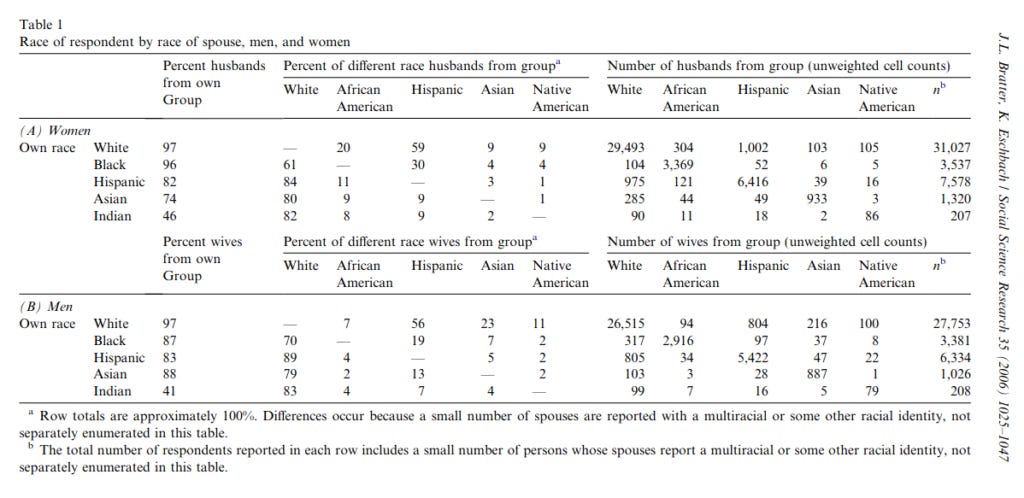
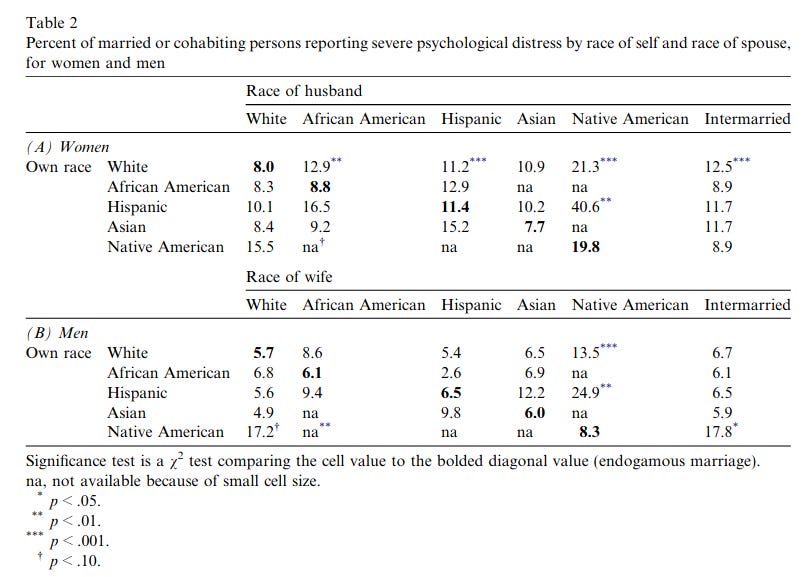
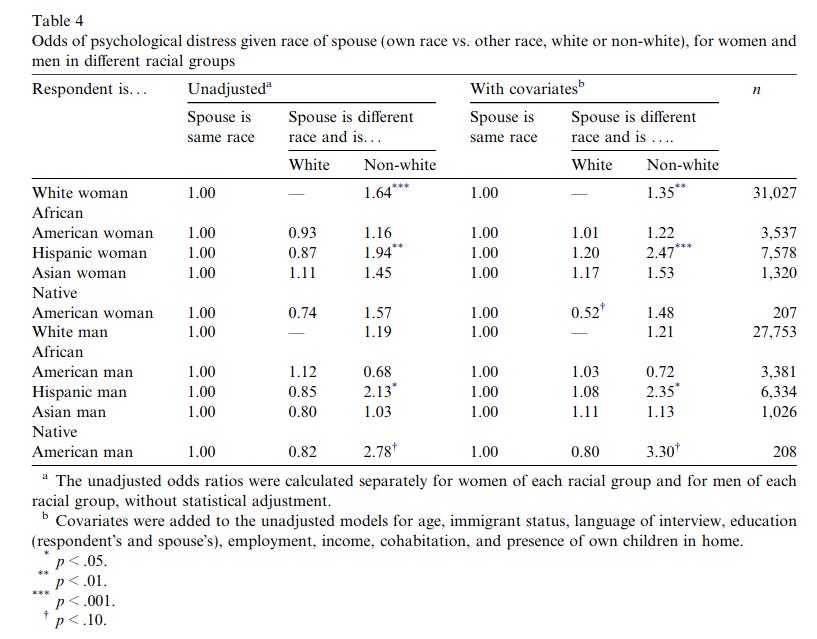
Bratter, J. L., & King, R. B. (2008). “But will it last?”: Marital instability among interracial and same‐race couples. Family Relations, 57(2), 160-171.
The literature on interracial families has examined social stigmas attached to interracial relationships but has not thoroughly documented whether crossing racial boundaries increases the risk of divorce. Using the 2002 National Survey of Family Growth (Cycle VI), we compare the likelihood of divorce for interracial couples to that of same‐race couples. Comparisons across marriage cohorts reveal that, overall, interracial couples have higher rates of divorce, particularly for those marrying during the late‐1980s. We also find race and gender variation. Compared to White/White couples, White female/Black male, and White female/Asian male marriages were more prone to divorce; meanwhile, those involving non‐White females and White males and Hispanics and non‐Hispanic persons had similar or lower risks of divorce.
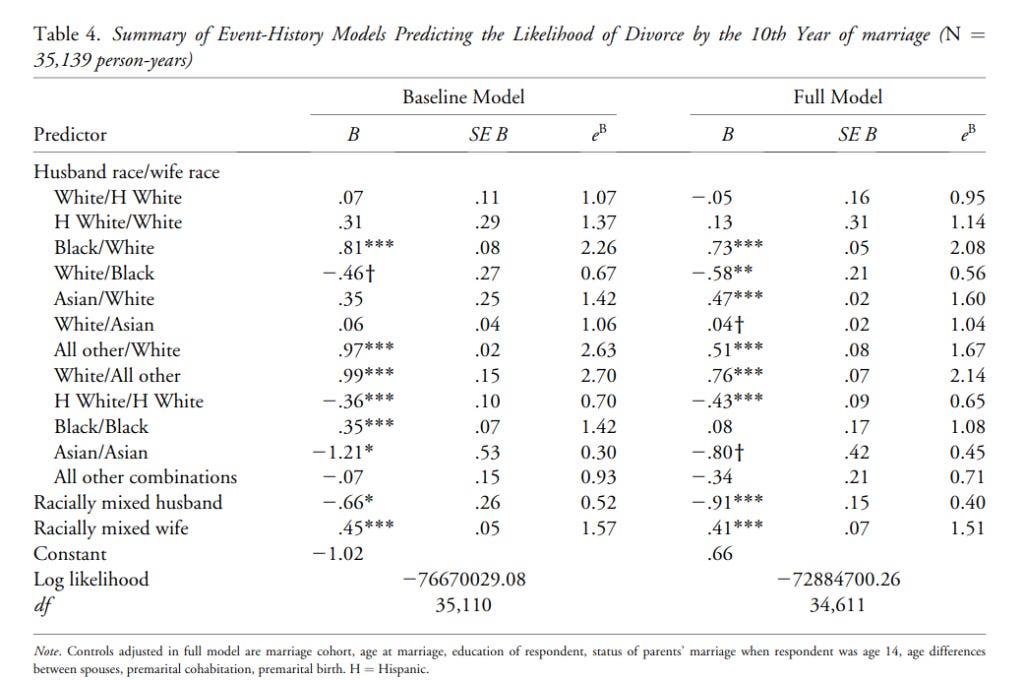
In response to my posting this evidence, Hispanic shitlord Yeyo adds this further study:
Saadat, M. (2015). Association between consanguinity and survival of marriages. Egyptian Journal of Medical Human Genetics, 16(1), 67-70.
Background and purpose: The present study was performed to investigate the association between consanguineous marriages and divorce risk. Materials and methods: A total of 496 couples at divorce time and 800 couples from general population who have no plan for divorce (as control group) were included in the study. Results: Compared to unrelated marriages, first cousin (OR= 0.39, 95% CI: 0.27–0.56, P < 0.001), first cousin once removed (OR =0.18, 95% CI: 0.05–0.62, P = 0.006) and second cousin marriages (OR= 0.37, 95% CI: 0.17–0.78, P =0.009) decreased the risk of divorce. The Cox proportional hazards regression analysis revealed that the survival of marriage was lower significantly for unrelated marriages than first cousin marriages, after adjusted for educational level (HR = 0.48, 95% CI: 0.35–0.67, P <0.001). Conclusion: The present findings indicate that consanguinity has some protective role(s) against divorce and also survival of marriages increased among consanguineous marriages. Considering that divorce rate is affected by several factors, replication of present findings in other populations is recommended.
Juicy. I don't know how much you trust the Egyptian Journal of Medical Human Genetics, but this is one funny finding.
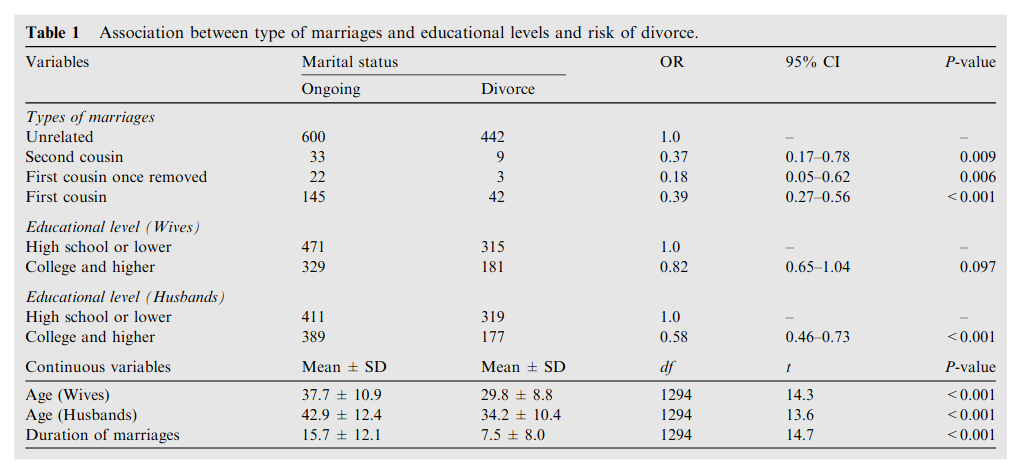
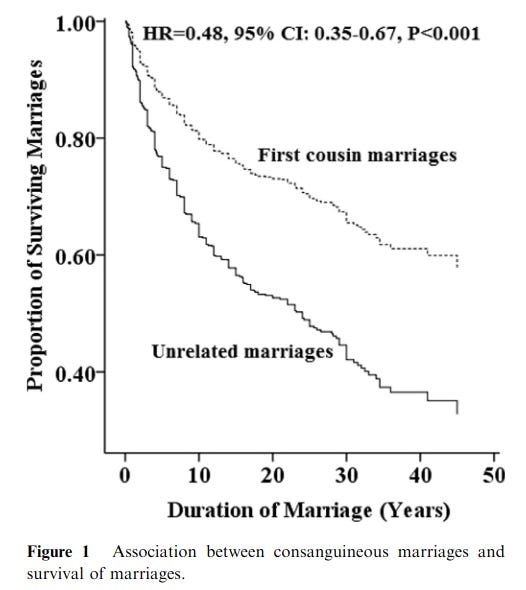
The evidence of first cousins once removed and second cousins is impressive. I can think of social pressure related reasons why first cousins may not want to split up, but second cousins generally do not know each other I would guess, maybe they do so in Egypt. Still, it seems to make a familial awkwardness explanation less likely. I was even able to find a replication of this:
Islam, M. M. (2021). Consanguineous marriage and its relevance to divorce, polygyny and survival of marriage: Evidence from a population-based analysis in Jordan. Annals of Human Biology, 1-23.
Background Consanguinity has been extensively studied in the context of its negative health outcomes for offspring and socio-demographic factors, but little evidence-based research has been done on its potential social benefits. Aim To examine the association between consanguineous marriage and the risk of divorce or separation, polygyny, and survival of marriage in Jordan. Subjects and Methods Data were obtained from the 2018 Jordan Population and Family Health Survey, covering a nationally representative sample of ever-married women of reproductive age. Descriptive statistics, multiple logistic regression, and survival analysis techniques were used for data analysis. Results The prevalence of consanguineous marriage was found to be 27.5% in Jordan in 2018, while the prevalence of polygyny and divorced/separated rates were 4.4% and 4.7%, respectively. Both consanguineous and polygyny rates showed declining trends, but divorce/separation rate showed an increasing trend. Compared to non-consanguineous marriages, the risk of divorce/separation and polygyny were found to be lower among women with consanguineous marriage, while the survival of marriages was found to be higher for consanguineous marriages than for non-consanguineous marriages. Conclusion Findings revealed that consanguinity has some social benefits as it plays protective roles against divorce or separation, polygyny and enhances the survival of marriages.
Readers may recall back in about 2008, there was also a related finding from Iceland:
Helgason, A., Pálsson, S., Guðbjartsson, D. F., & Stefánsson, K. (2008). An association between the kinship and fertility of human couples. Science, 319(5864), 813-816.
Previous studies have reported that related human couples tend to produce more children than unrelated couples but have been unable to determine whether this difference is biological or stems from socioeconomic variables. Our results, drawn from all known couples of the Icelandic population born between 1800 and 1965, show a significant positive association between kinship and fertility, with the greatest reproductive success observed for couples related at the level of third and fourth cousins. Owing to the relative socioeconomic homogeneity of Icelanders, and the observation of highly significant differences in the fertility of couples separated by very fine intervals of kinship, we conclude that this association is likely to have a biological basis.
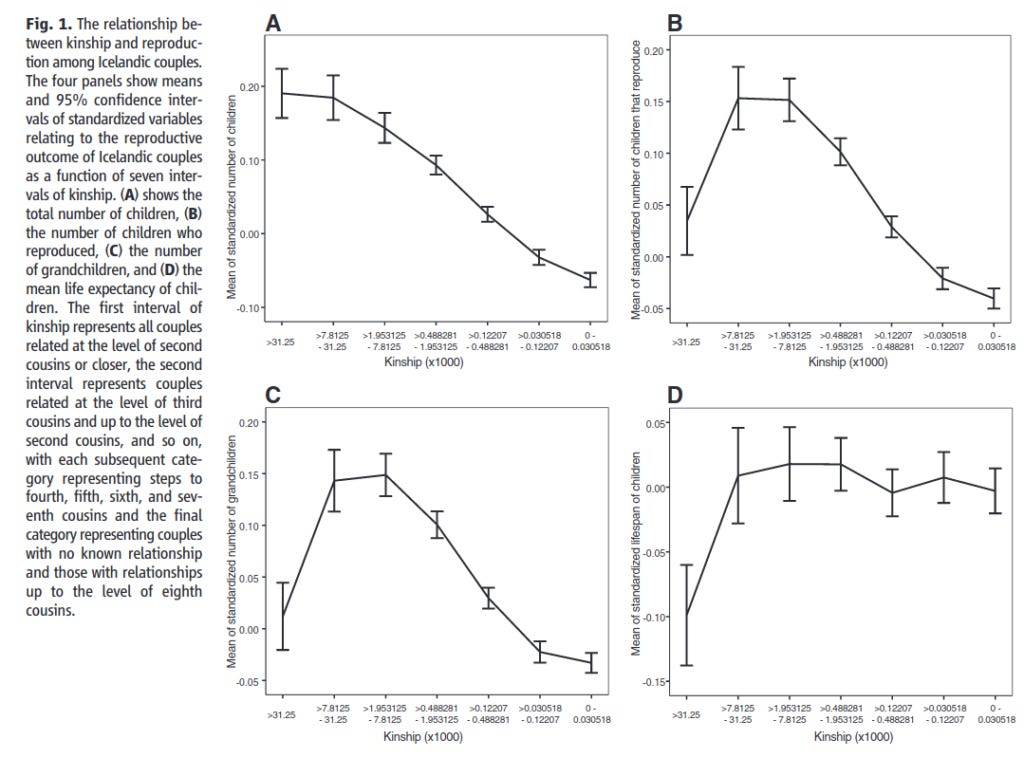
On a practical note then, it seems that Westerners might look to genetic testing services, so they can find out if they have any 3-4th cousins in the right age bracket. First date will be looking over the family tree together.

